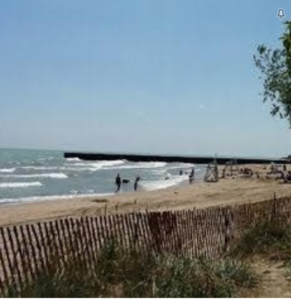The Evanston Public Library is committed to anti-racism and stands in solidarity with all who seek racial justice and equity.
 On Wednesday, July 29, a group of individuals openly displayed a Confederate Battle Flag at Lighthouse Beach in Evanston. Evanston resident LaShandra Smith-Rayfield confronted and filmed this group of people. She was later joined by other concerned Evanston residents who displayed Black Lives Matter signs, and peacefully protested against this group.
On Wednesday, July 29, a group of individuals openly displayed a Confederate Battle Flag at Lighthouse Beach in Evanston. Evanston resident LaShandra Smith-Rayfield confronted and filmed this group of people. She was later joined by other concerned Evanston residents who displayed Black Lives Matter signs, and peacefully protested against this group.
The Confederate Battle Flag has been a racist symbol from its creation. The design we are familiar with today was first created as part of the second Confederate national flag (“The Stainless Banner”), which was adopted on May 1, 1863, in part because the first Confederate national flag (the “Stars and Bars”) was thought to resemble the United States national flag too closely. William T. Thompson, the editor of the Savannah-based Daily Morning News, argued against the original Confederate flag, in an editorial on April 23, 1863, “on account of its resemblance to that of the abolition despotism against which we are fighting,” and in favor of the new flag, which he called “The White Man’s Flag.” His argument in favor of the new flag was that “As a people we are fighting to maintain the Heaven-ordained supremacy of the white man over the inferior or colored race; a white flag would thus be emblematical of our cause.”1 Furthermore, the Confederacy that this flag represented was formed with the explicit purpose of maintaining slavery and white supremacy, as can be plainly seen from The Declaration of Causes of Seceding States. Although those who promote the “Lost Cause” narrative have tried to revise history to pretend that the Civil War was fought over the issue of “states rights,” the Declaration of Causes of Seceding States make it clear that the Confederate states actually opposed states rights, at least when it came to the rights of the Union states to abolish slavery within their borders, or to refuse to return escaped slaves back into bondage.
For these reasons, and because of the adoption and continued display of the Confederate Battle Flag by numerous white supremacist organizations, this flag is recognized as a hate symbol by the Anti-Defamation League, the NAACP, and the Southern Poverty Law Center, among many others.
The Evanston Public Library will be participating in the Anti-Racism In Action’s “No One Is Free Until We Are All Free” event planned at Lighthouse Beach on Friday, July 31, from 2-4 PM, where we will be distributing free anti-racist books, as well as information on upcoming anti-racist programs at the library. We also encourage everyone to consult our recent list of Anti-Racist resources at https://www.epl.org/antiracist-resources-and-reads-lists-for-all-ages/, and the Evanston Public Library’s Commitment to Racial Equity here: https://www.epl.org/wp-content/uploads/2020/05/Equity-Statement-with-Spanish.pdf
1Coski, John M. (May 13, 2013). “The Birth of the ‘Stainless Banner'”. The New York Times.
